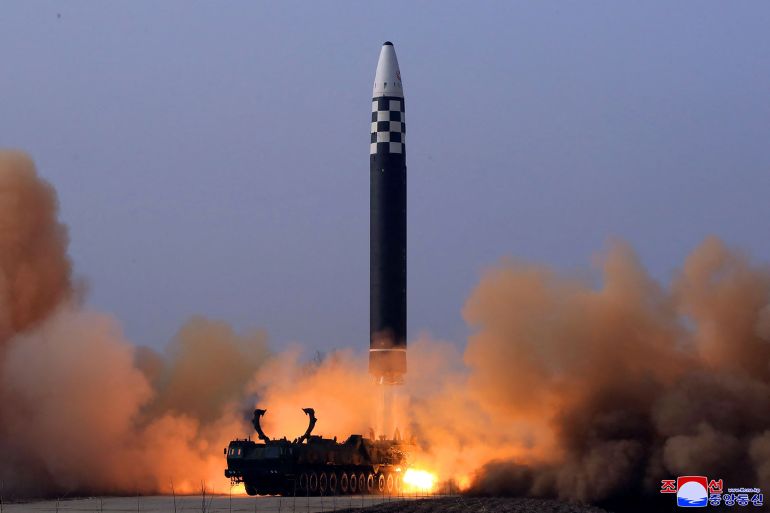Hwasong-17: North Korea’s ‘monster missile’
Analysts say the weapon Is the largest road-mobile, liquid-fuelled ICBM in the world, and could be designed to carry multiple warheads.

North Korea has confirmed it test-fired its first intercontinental ballistic missile (ICBM) since 2017.
The Hwasong-17 is the biggest ICBM has ever developed and is potentially able to deliver a nuclear warhead to anywhere in the United States.
Keep reading
list of 4 itemsNorth Korea launches suspected ICBM in first such test since 2017
Latest North Korea projectile launch ends in failure
North Korea fires ballistic missile ahead of S Korea election
Some analysts have called it a “monster missile”.
Here is what we know about the Hwasong-17:
Specifications
North Korea’s official KCNA news agency says the Hwasong-17 flew 1,090 km (681 miles) at a maximum altitude of 6,248.5 km (3,905 miles) and hit a target in the Sea of Japan during the Thursday test.
It was in the air for 67.5 minutes.
The numbers are similar to data reported by Japan and South Korea.
Its predecessor, the Hwasong-15, which was tested in November 2017 reached an altitude of about 4,475 km and covered 950 km over 53 minutes.
Unlike North Korea’s previous ICBM tests, the Hwasong-17 was launched directly from a Transporter Erector Launcher (TEL) vehicle, with 11 axles, KCNA photos showed.
This is also the first time we have seen #NorthKorea launch any ICBM directly from a TEL (Transporter Erector Launcher), for previous Hwasong-14 & 15 launches the stand was detached so as not to risk their precious few Chinese origin TEL. pic.twitter.com/31TgOkfBYd
— Joseph Dempsey (@JosephHDempsey) March 24, 2022
Analysts say that makes the Hwasong-17 the largest road-mobile, liquid-fuelled ICBM in the world.
Its diameter is estimated to be between 2.4 and 2.5 metres, and its total mass, when fully fuelled, is probably somewhere between 80,000 and 110,000 kg (176,000 and 242,500 pounds), according to 38 North, a US-based programme that monitors North Korea.
Development
The weapon was first seen at a military parade to mark the 75th anniversary of the founding of the ruling Workers’ Party in October 2020 with analysts noting it looked “considerably larger” than the Hwasong-15.
It was displayed for a second time at a defence exhibition in Pyongyang in October the following year. After examining photos of the exhibit, analysts concluded the official designation of the ICBM was most likely Hwasong-17.
It is thought that two previous tests – on February 27 and March 5 – involved different parts of the weapon.
The size of the Hwasong-17 has prompted speculation among analysts that it will be designed to carry multiple warheads and decoys to better penetrate missile defences.
Some observers say the satellite technology that North Korea claimed to have tested in the February 27 and March 5 launches could also be used for a multiple independently targetable reentry vehicle (MIRV) system — potentially allowing a single missile to drop nuclear warheads on different targets.